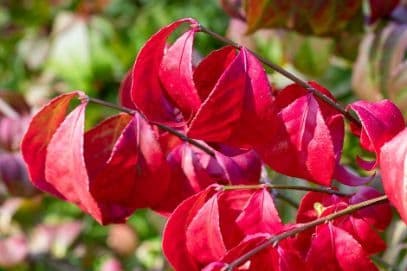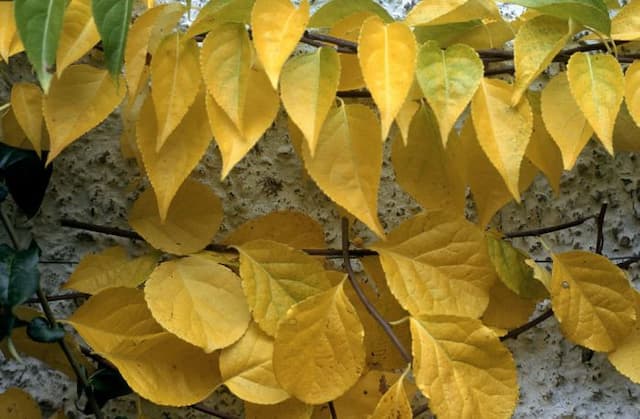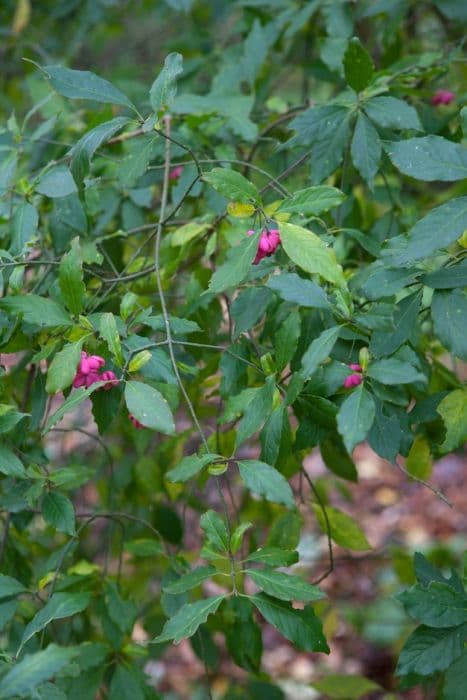Japanese Spindle Euonymus japonicus 'Benkomasaki'
ABOUT
Euonymus japonicus 'Benkomasaki', commonly known as the Japanese spindle, is an ornamental shrub with a distinctive and appealing appearance. This particular cultivar has glossy green leaves that are persistent throughout the year, providing a constant display of lush foliage. The leaves are oval to lanceolate with a finely toothed margin, giving them a delicate and elegant texture. The Japanese spindle possesses a dense, bushy habit with branches that are richly clothed in the vibrant leaves. During the blooming season, the Japanese spindle 'Benkomasaki' produces inconspicuous flowers that are small and often unnoticed amid the dense foliage. These flowers are typically a greenish-white hue, lending a subtle contrast to the dark green leaves. As the season progresses, the plant may bear fruit in the form of small, spherical berries that can range in color from pink to red or even a purplish hue, depending on the time of year and environmental conditions. The overall appeal of the Japanese spindle is complemented by its well-structured form, making it a popular choice for hedges, topiary, or as a standalone specimen in a landscape. Its refined appearance is well-suited to formal garden settings but can be equally at home in more casual or naturalistic designs. The Japanese spindle is appreciated for its hardiness, as well as its ability to withstand pruning, which allows gardeners to maintain its shape and size according to their landscaping needs.
About this plant
 Names
NamesFamily
Celastraceae.
Synonyms
Japanese Spindle, Evergreen Spindle, Japanese Euonymus.
Common names
Euonymus japonicus 'Benkomasaki'
 Toxicity
ToxicityTo humans
The Japanese spindle is considered toxic if ingested. All parts of the plant contain alkaloids that can cause symptoms such as nausea, vomiting, diarrhea, weakness, chills, coma, and convulsions if consumed in large quantities. Ingesting parts of the plant can lead to serious poisoning and medical attention should be sought immediately if ingestion occurs.
To pets
The Japanese spindle is also toxic to pets and can cause similar symptoms as in humans if ingested. These symptoms include vomiting, diarrhea, weakness, and more severe cases may lead to seizures or coma. It's important to prevent pets from chewing on or ingesting any part of the plant and to contact a veterinarian immediately if you suspect your pet has consumed any part of a Japanese spindle.
 Characteristics
CharacteristicsLife cycle
Perennials
Foliage type
Evergreen
Color of leaves
Green
Height
6 feet (1.8 meters)
Spread
2 feet (0.6 meters)
Plant type
Shrub
Hardiness zones
6
Native area
Japan
Benefits
 General Benefits
General Benefits- Ornamental value: Euonymus japonicus 'Benkomasaki', commonly referred to as Japanese Spindle, is known for its elegant and narrow upright form, adding architectural interest to gardens and landscapes.
- Drought tolerance: Once established, this plant has a reasonable level of drought resistance, making it suitable for xeriscaping and water-conserving gardens.
- Pest resistance: Japanese Spindle is relatively resistant to pests, reducing the need for chemical pesticides in the garden.
- Low maintenance: It requires minimal pruning and care once established, making it ideal for busy gardeners or those looking for low-maintenance landscaping options.
- Versatile landscaping uses: This shrub can be used for hedges, screens, or as a stand-alone specimen, offering flexibility in garden design.
- Evergreen foliage: The plant provides year-round greenery and structure, ensuring the garden remains attractive even in the winter months when other plants may have died back.
- Shade tolerance: It can grow in a variety of light conditions, including partial shade, offering solutions for less sunny areas in the garden.
 Medical Properties
Medical PropertiesThis plant is not used for medical purposes.
 Air-purifying Qualities
Air-purifying QualitiesThis plant is not specifically known for air purifying qualities.
 Other Uses
Other Uses- Euonymus japonicus 'Benkomasaki', commonly known as Japanese Spindle, can be used as a natural dye, producing various shades of yellow, green, and brown depending on the mordant used.
- The wood of Japanese Spindle is fine-grained and can be used in woodworking for creating small objects like handles, inlays, and intricate carvings.
- Its densely packed leaves make it suitable for use as a privacy screen in gardens or terraces, helping to block the view from outside observers.
- Dried branches and leaves of Japanese Spindle can be incorporated into potpourri mixes for a subtle, woodsy aroma.
- Foliage from the Japanese Spindle can serve as a natural insect repellent when placed among clothes and linens to deter moths.
- The plant can be crafted into natural wreaths and garlands for decorative purposes during holidays or in floral arrangements.
- Japanese Spindle can be trained and shaped into intricate forms for bonsai, adding an artistic element to indoor or outdoor spaces.
- The stiff branches can be used in the construction of small outdoor fences or garden trellises to support other climbing plants.
- In landscape design, Japanese Spindle is utilized as a backdrop to enhance the colors of flowering plants due to its evergreen nature and consistent foliage.
- The seeds of Japanese Spindle can be used for educational purposes to teach children about the life cycle of plants and how to grow them from seed.
Interesting Facts
 Feng Shui
Feng ShuiThe Japanese Spindle is not used in Feng Shui practice.
 Zodiac Sign Compitability
Zodiac Sign CompitabilityThe Japanese Spindle is not used in astrology practice.
 Plant Symbolism
Plant Symbolism- Longevity: Euonymus japonicus 'Benkomasaki', commonly known as Japanese Spindle, is an evergreen plant, symbolizing long life and permanence due to its ability to remain green throughout the year.
- Stability: As a sturdy shrub that can withstand various environmental conditions, the Japanese Spindle represents stability and resilience.
- Protection: With its dense foliage, the Japanese Spindle is often used in hedges, which can be seen as providing a protective barrier, symbolizing safeguarding and defense.
- Good Fortune: In some cultures, the vibrant green leaves of the Japanese Spindle are associated with prosperity and good luck, making it a plant that is often used in celebratory or auspicious occasions.
 Water
WaterJapanese Spindle should be watered regularly to maintain moist but not waterlogged soil, especially during the growing season. Aim to water this plant once every week with approximately 1-2 gallons, depending on the size and age of the plant, and the environmental conditions. In hot, dry spells, you may need to water twice a week, while in cooler or rainy periods, watering frequency should be reduced. Ensure that the container or garden bed has proper drainage to prevent root rot. Adjust watering during the fall and winter when the plant's growth slows down, typically reducing to every two weeks or when the topsoil feels dry to the touch.
 Light
LightJapanese Spindle thrives best in full sun to partial shade. Position the plant in a location where it can receive at least four to six hours of direct sunlight daily, although it can tolerate dappled light. Avoid placing it in deep shade as this can lead to poor growth and fewer leaves.
 Temperature
TemperatureThe Japanese Spindle is hardy and can tolerate a range of temperatures, thriving ideally between 50°F to 75°F. It can survive minimum temperatures down to around 0°F, but prolonged exposure to such cold may cause damage. During hot summer days, ensure the plant has adequate water to prevent heat stress.
 Pruning
PruningPrune Japanese Spindle to maintain shape and remove any dead or diseased branches. The best time for pruning is in late winter or early spring before new growth begins. Typically, pruning can be done annually or as needed to shape the plant and encourage bushier growth, removing up to one-third of the old growth.
 Cleaning
CleaningAs needed
 Soil
SoilJapanese Spindle 'Benkomasaki' thrives best in well-draining soil that is rich in organic matter with a slightly acidic to neutral pH, typically between 6.0 and 7.5. A mix of loamy soil, peat moss, and perlite or coarse sand is ideal to ensure good drainage and aeration around the roots.
 Repotting
RepottingThe Japanese Spindle 'Benkomasaki' should generally be repotted every 2-3 years, or when it becomes root-bound. Spring is the best season for repotting to ensure the plant has time to establish in the new container before winter.
 Humidity & Misting
Humidity & MistingThe Japanese Spindle 'Benkomasaki' tolerates a wide range of humidity levels but prefers moderate humidity. It will grow well in typical indoor environments without the need for additional humidity.
 Suitable locations
Suitable locationsIndoor
Place in bright, indirect light and water moderately.
Outdoor
Plant in partial shade to full sun, protect from strong winds.
Hardiness zone
6-9 USDA
 Life cycle
Life cycleEuonymus japonicus 'Benkomasaki', commonly known as Japanese Spindle 'Benkomasaki', begins its life cycle as a seed, which, once germinated in suitable conditions, sprouts into a seedling. The seedling stage is marked by the development of the plant's first leaves as it establishes a root system. As it grows into a young plant, it enters a vegetative stage characterized by rapid foliage growth and stem development. Once mature, the Japanese Spindle 'Benkomasaki' enters the reproductive phase, producing flowers that, upon pollination, develop into fruit containing seeds. The plant reaches maturity and may continue to grow larger, producing flowers and seeds annually. Over time, the plant may enter a period of decline due to age or environmental stresses, eventually completing its life cycle with death.
 Propogation
PropogationPropogation time
Spring-Early Summer
The most popular method of propagating Euonymus japonicus 'Benkomasaki', commonly known as Japanese Spindle 'Benkomasaki', is through softwood cuttings. The ideal time to take cuttings is in the late spring or early summer when new growth is still flexible. Cuttings should be about 4 to 6 inches long and include several leaf nodes. The lower leaves are removed, and the cut end is dipped into a rooting hormone before being planted in a well-drained potting mix. The cutting should be placed in a warm, humid environment but out of direct sunlight to encourage root development. It typically takes several weeks for roots to form, after which the new plant can be gradually acclimatized to less humid conditions before being transplanted outdoors.







